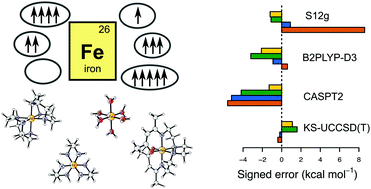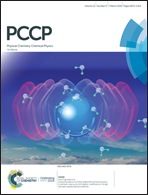Benchmarking quantum chemistry methods for spin-state energetics of iron complexes against quantitative experimental data†
Abstract
The accuracy of relative spin-state energetics predicted by selected quantum chemistry methods: coupled cluster theory at the CCSD(T) level, multiconfigurational perturbation theory (CASPT2, NEVPT2), multireference configuration interaction at the MRCISD+Q level, and a number of DFT methods, is quantitatively evaluated by comparison with the experimental data of four octahedral iron complexes. The available experimental data, either spin-forbidden transition energies or spin crossover enthalpies, are corrected for relevant environmental effects in order to derive the quantitative benchmark set of iron spin-state energetics. Comparison of theory predictions with the resulting reference data: (1) validates the high accuracy of the CCSD(T) method, particularly when based on Kohn–Sham orbitals, giving the maximum error below 2 kcal mol−1 and the mean absolute error (MAE) below 1 kcal mol−1; (2) corroborates the tendency of CASPT2 to systematically overstabilize higher-spin states by up to 5.5 kcal mol−1; (3) confirms that the latter problem is partly remedied by the recently proposed CASPT2/CC approach [Phung et al., J. Chem. Theory Comput., 2018, 14, 2446–2455]; (4) demonstrates that NEVPT2 performs worse than CASPT2, by giving errors up to 7 kcal mol−1; (5) shows that the accuracy of MRCISD+Q spin-state energetics strongly depends on the size-consistency correction: the Davidson–Silver and Pople corrections perform best (MAE < 3 kcal mol−1), whereas the standard Davidson correction is not recommended (MAE of 7 kcal mol−1). Only a few DFT methods (including the best performing ones identified in this study: B2PLYP-D3 and OPBE) are able to provide a balanced description of the spin-state energetics for all four studied iron complexes simultaneously, corroborating the non-universality problem of approximate density functionals.

- This article is part of the themed collection: 2019 PCCP HOT Articles


 Please wait while we load your content...
Please wait while we load your content...